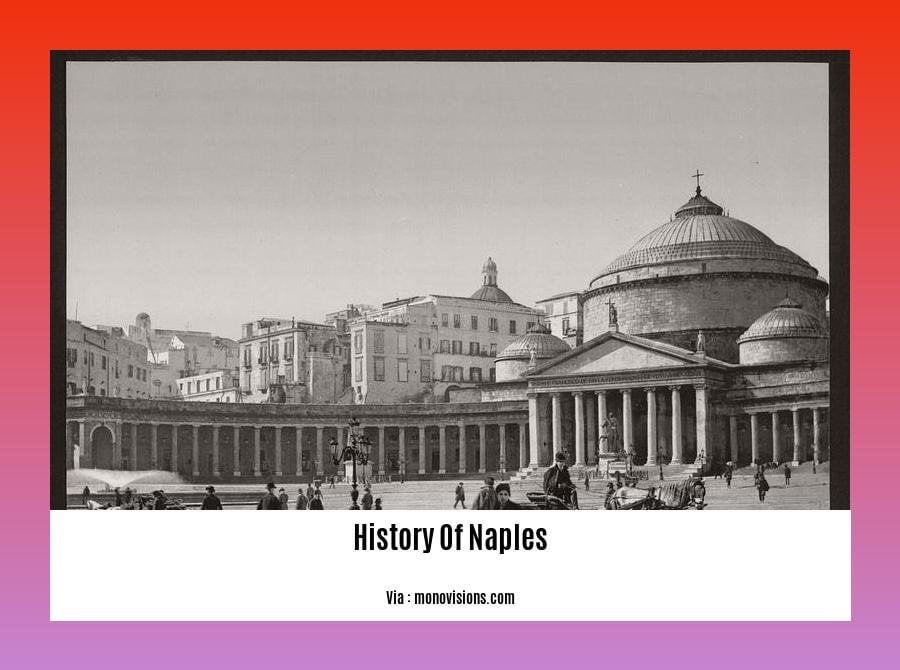Unveiling the rich tapestry of history, we embark on an enthralling journey titled “The History of Naples: Unraveling the Tapestry of a City’s Past.” Embarking on a voyage through the annals of time, we will explore the pivotal moments that have shaped and molded the vibrant city of Naples, Italy. From the grandeur of the Middle Ages to the splendor of the Renaissance era and beyond, we will delve into the cultural influences and societal shifts that have left an indelible imprint upon this captivating Italian city.
Key Takeaways:
- Humans first settled in Naples during the Middle Neolithic era.
- A Mycenaean settlement arose near where Naples would be in the second millennium BCE.
- Parthenope, named after a siren in Greek mythology, was founded by Cumae in the 8th century BCE.
- Parthenope grew into a large mainland colony on Pizzofalcone hill in the 8th century BCE.
History of Naples

The history of Naples, a vibrant city in southern Italy, is a captivating tale of diverse cultures, empires, and historical events that have shaped its unique identity.
Ancient Origins
The earliest traces of human presence in Naples date back to the Middle Neolithic period, with the first permanent settlements emerging in the second millennium BCE. During this time, the Greeks founded the city of Parthenope, named after the siren in Greek mythology who washed ashore here. Parthenope later developed into a larger colony known as Neapolis, which means “new city” in Greek.
Roman Conquest
In the 4th century BCE, Naples fell under Roman rule, becoming an important port city and a strategic military base. During this period, the city underwent significant expansion and development, with the construction of roads, aqueducts, and theaters. Naples also became a center of commerce and trade, connecting the Roman Empire with the Mediterranean region.
Medieval Period
With the fall of the Roman Empire, Naples was ruled by a succession of Germanic tribes and Byzantine Greeks. In the 9th century, the city became the capital of the Duchy of Naples, which was an independent state until it was conquered by the Normans in the 12th century. Under Norman rule, Naples flourished and became a center of culture, art, and learning.
Angevin and Aragonese Rule
In the 13th century, the Angevin dynasty took control of Naples, bringing with them French influences and a new wave of artistic and intellectual development. The city became a major center of the Renaissance, with artists such as Giotto, Caravaggio, and Raphael leaving their mark on the city’s churches and palaces.
In the 15th century, the Aragonese dynasty succeeded the Angevins, ruling Naples for over 200 years. During this period, the city experienced a golden age, with the construction of magnificent buildings, the expansion of the port, and the establishment of a university.
Spanish and Bourbon Rule
In the 16th century, Naples came under Spanish rule, which lasted for over two centuries. During this time, the city faced economic decline, natural disasters, and revolts, leading to a period of stagnation. In the 18th century, the Spanish were succeeded by the Bourbon dynasty, who brought a period of reforms and modernization to the city.
Unification of Italy
In the 19th century, Naples played a key role in the unification of Italy. In 1861, the city became part of the newly formed Kingdom of Italy, and it served as the capital of the country until 1865. During this period, Naples underwent significant redevelopment and modernization, with the construction of new roads, bridges, and public buildings.
Modern Naples
In the 20th century, Naples faced challenges such as industrial decline, poverty, and organized crime. However, the city has also experienced a resurgence in recent years, with a focus on tourism, culture, and urban renewal. Naples remains a vibrant and diverse city, with a rich historical legacy that continues to shape its identity and attract visitors from around the world.
Are you curious about the rich history of Naples, Italy? Dive into the intriguing journey of this vibrant city by exploring its captivating past through our comprehensive article on history of Naples Italy.
Discover the fascinating history of Nigeria before independence, a time of cultural diversity, colonial rule, and the struggle for freedom. Learn more about this transformative period that shaped the nation’s identity.
Embark on a historical odyssey through Nigeria’s journey from 1960 to the present. Explore the significant events, advancements, and challenges that have shaped the nation’s trajectory since independence. Unravel the story of a nation’s growth, resilience, and aspirations.
History of Naples, Italy: A Wikipedia Exploration

Key Takeaways:
Greek settlements established in the area in the 2nd millennium BC, beginning the long and varied history of Naples.
Played a vital role in Magna Graecia, influencing Roman society through its Greek culture.
Served as the capital of the:
Duchy of Naples (661–1139)
Kingdom of Sicily
Kingdom of Naples (1282–1816)
Two Sicilies
Rebelled against the Bourbon monarchs during the Neapolitan War, sparking the push for Italian unification.
Today, Naples is part of the Italian Republic and has the third-largest municipality by population after Rome and Milan.
Imagine a city that encompasses the grandeur of ancient Greece, the power of the Roman Empire, and the passion of modern Italy. That city is Naples, a vibrant tapestry of history, art, and culture.
Located in southern Italy, Naples traces its roots back to the 2nd millennium BC when Greek settlers established a colony in the area. This Greek influence laid the foundation for Naples’s rich cultural heritage, which would later be shaped by Roman rule and the rise of Christianity.
Naples played a pivotal role in the ancient world as part of Magna Graecia, a region comprising Greek colonies in southern Italy. The city’s Greek heritage left an indelible mark on Roman society, influencing everything from art and architecture to philosophy and politics.
Over the centuries, Naples served as the capital of various kingdoms and empires. In the 6th century AD, it became the capital of the Duchy of Naples, a Byzantine province. In the 13th century, it was conquered by the Normans and became the capital of the Kingdom of Sicily.
In the 15th century, Naples became the capital of the Kingdom of Naples, an independent state that lasted until the 19th century. During this period, the city flourished as a center of art, culture, and commerce. Naples was also home to a vibrant intellectual community, which attracted scholars and artists from all over Europe.
In the 19th century, Naples played a significant role in the unification of Italy. In 1848, the city rebelled against the Bourbon monarchs, sparking a wave of revolutions that eventually led to the creation of the Italian state.
Today, Naples is a modern, bustling city that retains its deep connection to history. From the ancient ruins of Pompeii to the majestic Castel Nuovo, Naples is a treasure trove of historical and cultural wonders.
And there’s more to explore! Delve deeper into the captivating history of Naples by visiting the Wikipedia page dedicated to this extraordinary city. Discover the stories, events, and personalities that have shaped Naples into the vibrant metropolis it is today.
Sources:
History of Naples – Wikipedia
Naples – Wikipedia
History Of Naples Italy
Nestled between the cerulean waters of the Tyrrhenian Sea and the brooding presence of Mount Vesuvius, Naples is a city steeped in history and culture. From its humble beginnings as a cluster of Greek settlements in the 2nd millennium BC to its current status as the vibrant capital of Campania, Naples has witnessed centuries of transformation and upheaval, shaping its unique identity and captivating allure.
Key Takeaways:
- Ancient Origins: Naples traces its roots to the ancient Greeks, who founded the city of Parthenope in the 8th century BC, later renamed Neapolis by the Romans.
- Roman Influence: Under Roman rule, Naples flourished as a major port and trading hub, gaining prominence as a cultural center in Southern Italy.
- Medieval Kingdoms: During the Middle Ages, Naples served as the capital of the Kingdom of Naples,见证了诺曼人,安籍人和阿拉贡人的统治。
- Spanish Domination: In the 16th century, Naples fell under Spanish rule, leaving a lasting impact on the city’s art, architecture, and cuisine.
- Birthplace of Pizza: Naples is widely regarded as the birthplace of pizza, with the iconic dish originating in the city’s streets in the 18th century.
- World War II Devastation: Naples suffered significant damage during World War II, but its resilience and spirit shone through as it rebuilt and restored its landmarks.
Naples: A City of Layers
Naples is a city of layers, its history etched into its ancient streets, majestic monuments, and vibrant traditions. From the grandeur of the Castel Nuovo, a symbol of Angevin rule, to the haunting ruins of Pompeii, frozen in time by the catastrophic eruption of Mount Vesuvius, Naples is a living testament to its rich past.
The Neapolitan Spirit
The people of Naples, known as Neapolitans, are renowned for their passion, warmth, and resilience. Their unique dialect, a blend of Italian and Spanish influences, reflects the city’s diverse heritage. Naples is also a culinary paradise, where the aroma of freshly baked pizza and the taste of velvety espresso permeate the air, enticing visitors with every step.
A Cultural Tapestry
Naples is a city where art, music, and literature converge, creating a vibrant cultural tapestry. The city’s museums, such as the National Archaeological Museum and the Capodimonte Museum, house a treasure trove of ancient artifacts and masterpieces, showcasing the artistic legacy of Naples and the region.
Conclusion
Naples, with its captivating history, vibrant culture, and indomitable spirit, stands as a testament to the enduring power of the human spirit. Its unique blend of ancient heritage, medieval influences, and modern vitality makes it a city that continues to enchant and inspire, leaving an indelible mark on the hearts of those who visit.
Citations:
– History of Naples
– A History of Naples
FAQ
Q1: What was the significance of Naples during the Middle Ages?
A1: During the Medieval era, Naples flourished as a prominent city-state and served as the capital of the Duchy of Naples from 661 to 1139. It played a crucial role in trade and commerce throughout the Mediterranean region.
Q2: How did the Renaissance influence Naples?
A2: Naples embraced the ideals of the Renaissance, becoming a hub for artistic and intellectual pursuits. The city witnessed the construction of magnificent palaces, churches, and public buildings, reflecting the artistic brilliance of the period. Many renowned Renaissance artists, including Raphael and Michelangelo, left their mark on the city.
Q3: What was the role of Naples in the unification of Italy?
A3: Naples played a pivotal role in the Italian unification movement. In 1848, the city revolted against the Bourbon monarchy, sparking a series of uprisings that eventually led to the unification of Italy under the leadership of Giuseppe Garibaldi.
Q4: How did World War II impact Naples?
A4: Naples suffered significant damage during World War II, particularly during the Allied bombings aimed at disrupting German supply lines. However, the city’s resilience and resistance to Nazi occupation earned it the title of “the first city to rise” in the Italian struggle for liberation.
Q5: What are some of the notable landmarks and cultural aspects of Naples?
A5: Naples boasts a wealth of historical landmarks, including the Castel Nuovo, the Royal Palace, and the Duomo. The city is also renowned for its vibrant street life, traditional Neapolitan cuisine, and its passion for music, particularly the Neapolitan song.
- Cloak of Elvenkind 5e: A Comprehensive Guide to Stealth and Invisibility - December 19, 2024
- Travailler Conjugation: Your Complete Guide to All Tenses and Moods - December 19, 2024
- Mastering the Bearded Devil in 5e: Tactics, Lore, and Infernal Strategies - December 19, 2024













